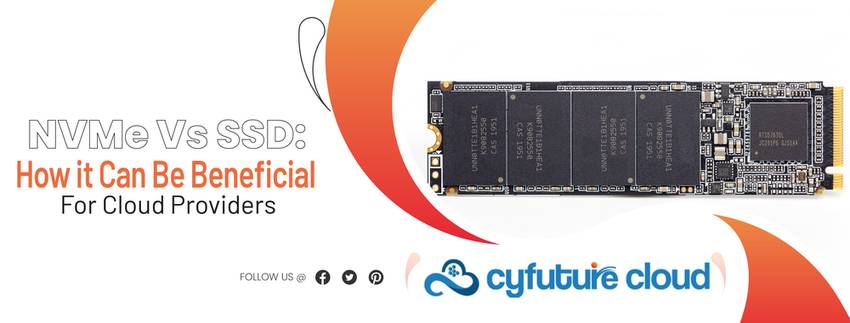NVMe Vs SSD: How it Can Be Beneficial For Cloud Providers

Table of Contents
In the skirmish of NVMe vs SSD, the previous gives an inactivity-free and high-transfer speed capacity experience. It is the most recent and potentially the best cloud storage provider in India that answers for various gadgets, offering quicker read and compose speeds than more established arrangements.
However, these advantages include some significant disadvantages, contingent upon how you’ll utilize them. Consequently, as a rule, you want to consider assuming it merits paying something else for a cloud NVMe set-up.
Remembering this, we have investigated the web and sprinkled our encounters with cloud service providers in India to compose this blog to assist you with settling on an educated choice.
What are NVMe and SSD? How would They Differ From Each Other?
All things considered, when we discuss PC stockpiling, we are talking about hard drives. Moreover, there are three hard drives: SSD, SATA, and NVMe. Every one of these works in an unexpected way. Subsequently, its hard to make the right choice.
However, stress not! We’ll assist you with understanding how each of these arrangements functions and how to pick the most practical choice for your business.
Initially, we should examine a piece about the development of the cloud server SSD. Strong State Drive (SSD) has been the most well-known equipment for PCs and workstations long term. Unlike its more seasoned partner, the Hard Disk Drive (HDD), SSD doesn’t have moving parts. It utilizes semiconductor chips to store and access memory.
The most fascinating thing about an SSD is that these chips hold their charged or uncharged state; when you shut down the gadget, it is put away to guarantee memory. It permits your work area or PC to examine the information quickly.
NVMe VS SSD
At the point when SSDs were first sent off, makers guaranteed that they fit into the current HDD openings and straights. Accordingly, they had elements of 3.5 and 2.5 inches. In any case, more structure factors arose as innovation progressed quickly. More modest structure factors, like mSATA, PCIe, NVMe, and M.2, that interface straightforwardly with worked-in openings appeared. Albeit these drives additionally depend on a similar working rule as customary SSD, they have various elements, filling different needs.
NVMe represents Non-Volatile Memory Express. It is a capacity arrangement presented in 2013. In this arrangement, non-unstable means the capacity isn’t erased when your PC reboots. Simultaneously, explicitly characterizes how all information goes over the PCI Express (PCIe) interface on your PC’s motherboard.
Since information doesn’t need to bounce through a Serial Advanced Technology Attachment (SATA) regulator, it gives the driver a more straightforward association with your gadget’s motherboard, saving you a great deal of time while consuming insignificant assets. It’s an innovative portrayal of the transport; the memory part (SSD) used to speak with the PC and not, by and large, another sort of memory.
NVMe drives are way quicker than SATA. Speeds on significant business-level NVMe drives can reach 32Gb/s with a 3.9GB/s interface rate. It can be beneficial assuming that you accomplish something which requires bunches of circle execution, like gaming or video altering. With cloud server SSD, tracking down a careful speed matching your requirements isn’t tricky as it shifts by producer and structure factor.
Is NVMe Faster Than SSD?
NVMe (Non-Volatile Memory Express) is a protocol for accessing SSDs via the PCIe bus. Unlike traditional SSDs using SATA connections, NVMe drives offer significantly higher speeds due to their direct connection to the CPU via PCIe lanes, enabling faster data transfer rates and lower latency. This advancement results in exceptional read/write speeds, making NVMe drives notably quicker than conventional SSDs, thereby enhancing overall system performance, particularly in tasks that benefit from rapid data access and transfer, such as gaming, video editing, and large-scale data processing.
SSD Hosting vs Cloud Hosting
|
Factors |
SSD Hosting |
Cloud Hosting |
|
Storage |
Relies on SSDs for faster data retrieval |
Uses distributed storage across multiple servers |
|
Scalability |
Limited scalability based on hardware |
Highly scalable, resources can be scaled easily |
|
Performance |
Offers fast read/write speeds with SSDs |
Performance varies; can be optimized for needs |
|
Reliability |
Stable performance but can face hardware failures |
Offers redundancy and reliability via multiple servers |
|
Cost |
Generally more affordable for small-scale needs |
Costs vary based on usage, scalable configurations |
|
Flexibility |
Limited flexibility in resource allocation |
Offers flexible resource allocation and configurations |
|
Accessibility |
Primarily suited for smaller applications/websites |
Suitable for small to large-scale applications/websites |
|
Management |
Easier management due to fixed hardware |
Requires more sophisticated management due to distributed nature |
Looking at The Major Features of NVMe and SSD
At the point when we discuss standard SSD, it is an SSD with a SATA interface, a sensible connection point that associates an SSD through a SATA link or PCIe to the motherboard (M.2 goes under PCIe Interface). NVMe SSD implies an SSD with an NVMe Logical Interface related to an M.2 actual connection point or structure factor. NVMe is a sensible compositional calculation working inside the SSD and utilizing the M.2 point of interaction to give the quickest information move rate.
Now that you comprehend what SSD and NVMe mean, how about we check out the vast contrasts between the two arrangements:
-
Speed
You can see a reasonable and quantifiable distinction in execution while utilizing the NVMe cloud, which has a perused/composed throughput far more prominent than hard drives and SATA SSDs. NVMe drives are a great deal quicker than SATA drives. PCIe 3.0 — the PCI Express standard current age — has a most extreme speed move of 985 megabytes each second (Mbps) in every way. NVMe Drives can utilize 4 PCIe paths, which implies a hypothetical most excellent speed of 3.9 Gbps (3,940 Mbps).
-
Execution
NVMe permits drivers to profit from a similar path “pool” associated straightforwardly with the CPU. It gives adaptable execution, stretching past the regular four paths in most PCIe SSDs and involving them for execution. PCIe attachments move above multiple times more information than their SATA.
-
Value
Prices for SSDs shift extraordinarily contingent upon size and limit. Generally, SSD limits range between 120 GB to 2 TB and cost practically 4x the cost of a customary SATA drive of a similar arrangement. NVMe cloud might be the better undertaking decision for incredibly superior execution needs, yet it is exorbitant contrasted with SSDs.
-
Similarity
Irrespective of the structure factor, NVMe speaks with the CPU and works with all major frameworks. SSDs, then again, are intended for individual gadgets and aren’t viable across different gadgets or operational frameworks.
NVMe and SSD Performance Base: Which Is the Best?
SSDs have arrived where the SATA link has become a constraint to quicker moving speeds. There are a few types of SSD, and NVMe is one such structure. Other SSD designs incorporate 2.5″ SATA, mSATA, M.2 SATA, and card-design PCIe. In the midst of all of this, NVMe is the quickest.
SATA SSDs are original SSDs and can arrive at a most extreme read speed of 300MB each second, contingent upon the drive’s condition and fracture. Workstations utilize the most widely recognized SATA variation, the 2.5-inch SSD. The cutting-edge SATA–III variation offers Read/Write rates of nearly 600 MB each second. Practically all SATA SSDs use the AHCI (Advanced Host Controller Interface) convention to interact between the SATA drive and the PC, which builds inactivity and data transmission bottleneck.
NVMe is a more current convention that permits you to accomplish considerably higher information read and compose speeds by working with streamlined proficiency. According to Enterprise Forum, “the quickest NVMe drives, which are typically just accessible through OEM or too enormous undertaking clients, read 3 GB/s and compose at 1 GB/s”. Mid to low-even-out NVMe drives offer Read/Write speeds as high as 3500 MB each second. That is just multiple times the presentation given by SATA–III SSDs.
Unlike an AHCI regulator, the NVMe regulator offers lower dormancy and can handle 2,000 extra orders to or from the drive. To accomplish ideal execution from an NVMe drive, ensure it utilizes PCIe (Peripheral Component Interconnect Express) as transport instead of SATA.
Here is a speedy rundown summarizing the presentation norms of various sorts of SSDs:
-
NVMe Vs. SATA
NVMe offers Read/Write speeds up to 3500 MB/second, while the freshest SATA variation, SATA-III, offers the greatest 600 MB/second speed.
-
NVMe Vs. M.2
The M.2 connector permits SSDs to reach higher read/compose speeds. Assuming your NVMe SSD involves the M.2 regulator as transport, you can accomplish read/compose velocities of up to 2600 MB/second.
-
PCIe SSD Vs. NVMe
When an NVMe SSD is associated with a PCIe connector, you get the most extreme data transfer capacity and speed it brings. You’ll see massive contrasts while caring for enormous records (50 GB and higher).
When Should You Use NVMe and SSD?
Picking either NVMe or SSD relies upon grasping your necessities. NVMe is, for the most part, more costly than SATA-III. It is a critical issue because SATA-III hard drives are, as of now, expensive.
Cloud NVMe is useful if you want to work with enormous records consistently. Thus, video organizations and information-driven enterprises frequently favour NVMe over SATA-III. SSD works best when you don’t require a lot of extra room. For example, a PC offering 2TB capacity is enough for your regular requirements, like gaming and putting away recordings, pictures, and so on. Yet, assuming you’re assembling a perfect quality gaming PC. Managing vast measures of information. Making a capacity-concentrated server and doesn’t have a financial plan requirement. We enthusiastically suggest that you pick an NVMe drive.
Conclusion
While SATA is less expensive than NVMe, more established PCs mainly utilize this innovation. Then again, NVMe is another convention that permits elite execution, low dormancy, and gigantic extra room.
Assuming you are keeping watch for a quicker, more responsive stockpiling arrangement, you’ll need to look at the accessible NVMe cloud choices. It may very well be costly. However, the speculation is worth the effort. With imaginative arrangements like NVMe-oF (NVMe Over Fabrics) and Parallel I/O, NVMe stockpiling’s strength enlarges to something other than one application.
We trust this definite blog assists you with understanding the NVMe vs SSD contrasts. Assuming that you want a capacity answer for your business. Try to look at Systems, offering a variety of unified stockpiling equipment and programming for video experts, and groups. Organizations, including NVMe, drives, SSDs, resources for the executives, distributed storage, reinforcements, and documents, and that’s just the beginning.
Send this to a friend

 Server Colocation
Server Colocation CDN Network
CDN Network Linux Cloud Hosting
Linux Cloud Hosting Kubernetes
Kubernetes Pricing Calculator
Pricing Calculator
 Power
Power
 Utilities
Utilities VMware Private Cloud
VMware Private Cloud VMware on AWS
VMware on AWS VMware on Azure
VMware on Azure Service Level Agreement
Service Level Agreement 

